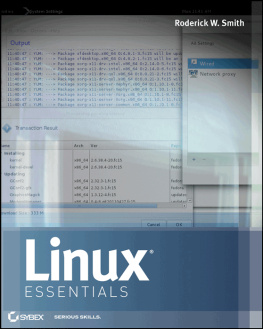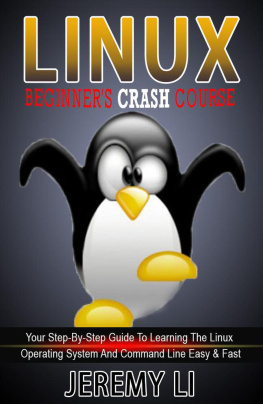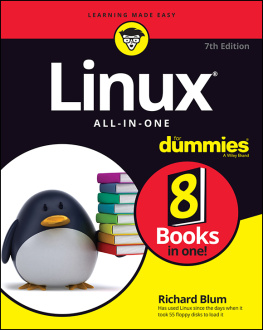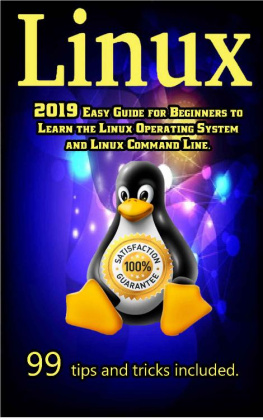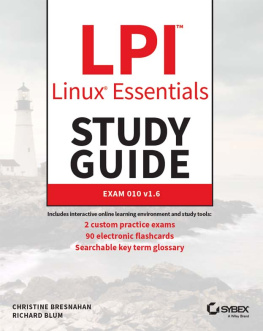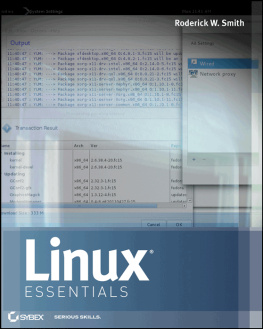Appendix A
Answers to ReviewQuestions
Chapter 1
C GUI programs create menus with the help of a library thats designed for this purpose; this is not a function of the Linux kernel. Thus, option C is a non-kernel function, and is correct. The kernel allocates memory and CPU time, and it also controls access to disk and network hardware, so options A, B, D, and E all describe kernel functions and are incorrect.
A Android is used on cell phones and other small portable devices, and as such it qualifies as an embedded OS, making option A correct. SUSE, CentOS, Debian, and Fedora are all examples of distributions intended mainly for use on desktop, laptop, and server computers; these do not qualify as embedded OSs, so options B, C, D, and E are all incorrect.
B Linuxs GUI is based on the X Window System. Although OS X provides an X implementation, its primary GUI is Apples proprietary product. Thus, option B is correct. Option A is incorrect because both Linux and OS X can run most GNU programs. Option C is incorrect because Linux can run on both Apple Macintosh and commodity PC hardware. Option D is incorrect because OS X includes many BSD utilities in its standard form. Furthermore, most Linux distributions use GNU utilities rather than their BSD equivalents, although you can use BSD utilities in Linux if you prefer. Option E is incorrect because both Linux and OS X support text-mode commands, although OS X makes it hard to use these commands in anything but its GUI Terminal application.
False The Linux kernel was intended as a from-scratch project to create a new Unix-like kernel. Although there are influences and similarities, the two kernels are largely independent of each other.
False Programs known as terminals enable entry of text-mode commands once youve logged into Linux in GUI mode. You can also switch between multiple virtual terminals by using keystrokes such as Ctrl+Alt+F2.
True CentOSs release cycle is approximately 2 years, which is long by the standards of Linux distributions, some of which have release cycles of just 6 months.
login:
viruses
alpha and beta
Chapter 2
A Linuxs multitasking is preemptive, meaning that the kernel can give CPU time to any process as it sees fit, potentially interrupting (or preempting) other processes. Thus, option A is correct. Linux is a multi-user OS, but multi-user is not a type of multitasking, so option B is incorrect. In a co-operative multitasking OS, applications must voluntarily give up CPU time to each other. Although Linux programs can signal the OS that they dont need CPU time, Linux doesnt rely exclusively on this method, so option C is incorrect. A single-tasking OS can run just one process at a time, so option D is incorrect. A single-user OS can support just one user at a time. Such OSs can be either single-tasking or multitasking, and in the latter case, could use either co-operative or preemptive multitasking. Thus, option E is incorrect.
C The open source definition includes ten points, one of which is that users may modify the original code and redistribute the altered version. Thus, option C is correct. Although as a practical matter all open source software is available at no charge, nothing in the open source definition forbids selling it. In practice, many organizations and individuals do sell open source software, either as a convenience (such as DVD-ROMs with Linux distributions for those with slow Internet connections) or in value-added arrangements (such as Red Hat Enterprise Linux, which bundles open source software with a support contract). Thus, option A is incorrect. The open source definition requires distribution of source code, but does not require distribution of binaries. Thus, option B is incorrect. Although some open source software, including the Linux kernel, began life in academia, this is not true of all open source software, so option D is incorrect. The open source definition does not specify that either an interpreted or a compiled language be used, and in fact both have been used to write open source software, so option E is incorrect.
D Evolution is an e-mail reader program. Such programs are common on desktop computers, so option D is correct. Apache is a Web server, Postfix is an e-mail server, and the Berkeley Internet Name Domain (BIND) is a Domain Name System (DNS) server. Such servers are much less likely to be installed on desktop computers than are client programs such as Evolution, so options A, B, and E are all incorrect. Android is the name of a Linux distribution for cell phones and tablets, so option C is incorrect.
False VMS was an OS for minicomputers and mainframes when Linux was created. On x 86 computers, DOS was the dominant OS in 1991.
True Digital video recorders (DVRs) are specialized computers for recording TV shows. Some commercial DVRs, such as TiVos, run Linux natively. DVR software for standard PCs, such as MythTV, which runs under Linux, also exists.
True Most server programs do not require the X Window System (X) GUI, so server computer administrators often disable X or even remove it entirely to save disk space and memory and to minimize the risk of security problems.
monolithic
shareware
desktop
Chapter 3
C The open source definition specifies that users be able to distribute changes, but it doesnt require that the license require distribution under the terms of the same license. Thus, option C does not describe an open source requirement, and so is the correct answer. Options A, B, D, and E all paraphrase actual open source license term requirements.
B Some distributions (particularly Enterprise versions that are sold for money) include software that is neither open source nor even freely redistributable, so option B is correct. Distributions as a whole use many licenses, not just one, so option A is incorrect. The MIT license is one of several open source licenses; such software is not an impediment to copying a distribution, so option C is incorrect. Although some distributions, such as Debian, aim to make their main systems fully open source compliant, not all do this, so option D is incorrect. Likewise, not all distributions are composed completely of free software as the FSF uses the term.
E Option E paraphrases one of the four key points in the FSFs philosophy, and so is correct. Contrary to option A, the FSFs philosophy does not mandate use of the GPL, much less its most recent version, although the GPL is the FSFs preferred license. Option B is contrary to the FSFs position, which is that free software should remain free; however, this option is compatible with the OSIs philosophy. Although the FSF advocates free software and free OSs, option C is not an explicit part of their philosophy and so is incorrect. Although the FSF wants to see a world dominated by free software, they do not advocate software piracy, so option D is incorrect.
True Courts and laws explicitly recognize computer software as being creative works that are governed by copyright law. In some countries, patent laws also apply to software, although this is not globally true.
True This principle is at the heart of both the free software and the open source software definitions.
False Hardware vendors often do release open source drivers for their products. One caveat is that the release of open source drivers necessarily renders some programming interfaces for the hardware open, which some hardware vendors are reluctant to do.
LGPL (or Lesser GPL, or Lesser General Public License)

